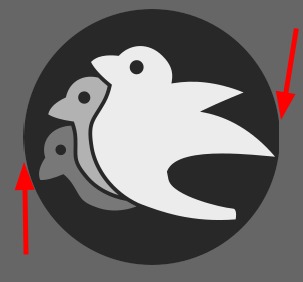This PR implements wireframe rendering.
Usage:
This is now ready as soon as #1401 gets merged.
Usage:
```rust
app
.insert_resource(WgpuOptions {
name: Some("3d_scene"),
features: WgpuFeatures::NON_FILL_POLYGON_MODE,
..Default::default()
}) // To enable the NON_FILL_POLYGON_MODE feature
.add_plugin(WireframePlugin)
.run();
```
Now we just need to add the Wireframe component on an entity, and it'll draw. its wireframe.
We can also enable wireframe drawing globally by setting the global property in the `WireframeConfig` resource to `true`.
Co-authored-by: Zhixing Zhang <me@neoto.xin>
OK, here's my attempt at sprite flipping. There are a couple of points that I need review/help on, but I think the UX is about ideal:
```rust
.spawn(SpriteBundle {
material: materials.add(texture_handle.into()),
sprite: Sprite {
// Flip the sprite along the x axis
flip: SpriteFlip { x: true, y: false },
..Default::default()
},
..Default::default()
});
```
Now for the issues. The big issue is that for some reason, when flipping the UVs on the sprite, there is a light "bleeding" or whatever you call it where the UV tries to sample past the texture boundry and ends up clipping. This is only noticed when resizing the window, though. You can see a screenshot below.

I am quite baffled why the texture sampling is overrunning like it is and could use some guidance if anybody knows what might be wrong.
The other issue, which I just worked around, is that I had to remove the `#[render_resources(from_self)]` annotation from the Spritesheet because the `SpriteFlip` render resource wasn't being picked up properly in the shader when using it. I'm not sure what the cause of that was, but by removing the annotation and re-organizing the shader inputs accordingly the problem was fixed.
I'm not sure if this is the most efficient way to do this or if there is a better way, but I wanted to try it out if only for the learning experience. Let me know what you think!
It took me a little while to figure out how to use the `SystemParam` derive macro to easily create my own params. So I figured I'd add some docs and an example with what I learned.
- Fixed a bug in the `SystemParam` derive macro where it didn't detect the correct crate name when used in an example (no longer relevant, replaced by #1426 - see further)
- Added some doc comments and a short example code block in the docs for the `SystemParam` trait
- Added a more complete example with explanatory comments in examples
I have run the VSCode Extension [markdownlint](https://marketplace.visualstudio.com/items?itemName=DavidAnson.vscode-markdownlint) on all Markdown Files in the Repo.
The provided Rules are documented here: https://github.com/DavidAnson/markdownlint/blob/v0.23.1/doc/Rules.md
Rules I didn't follow/fix:
* MD024/no-duplicate-heading
* Changelog: Here Heading will always repeat.
* Examples Readme: Platform-specific documentation should be symmetrical.
* MD025/single-title
* MD026/no-trailing-punctuation
* Caused by the ! in "Hello, World!".
* MD033/no-inline-html
* The plugins_guidlines file does need HTML, so the shown badges aren't downscaled too much.
* ~~MD036/no-emphasis-as-heading:~~
* ~~This Warning only Appears in the Github Issue Templates and can be ignored.~~
* ~~MD041/first-line-heading~~
* ~~Only appears in the Readme for the AlienCake example Assets, which is unimportant.~~
---
I also sorted the Examples in the Readme and Cargo.toml in this order/Priority:
* Topic/Folder
* Introductionary Examples
* Alphabetical Order
The explanation for each case, where it isn't Alphabetical :
* Diagnostics
* log_diagnostics: The usage of inbuild Diagnostics is more important than creating your own.
* ECS (Entity Component System)
* ecs_guide: The guide should be read, before diving into other Features.
* Reflection
* reflection: Basic Explanation should be read, before more advanced Topics.
* WASM Examples
* hello_wasm: It's "Hello, World!".
* use `length_squared` for visible entities
* ortho projection 2d/3d different depth calculation
* use ScalingMode::FixedVertical for 3d ortho
* new example: 3d orthographic
* add normalized orthographic projection
* custom scale for ScaledOrthographicProjection
* allow choosing base axis for ScaledOrthographicProjection
* cargo fmt
* add general (scaled) orthographic camera bundle
FIXME: does the same "far" trick from Camera2DBundle make any sense here?
* fixes
* camera bundles: rename and new ortho constructors
* unify orthographic projections
* give PerspectiveCameraBundle constructors like those of OrthographicCameraBundle
* update examples with new camera bundle syntax
* rename CameraUiBundle to UiCameraBundle
* update examples
* ScalingMode::None
* remove extra blank lines
* sane default bounds for orthographic projection
* fix alien_cake_addict example
* reorder ScalingMode enum variants
* ios example fix
- added some missing examples
- changed the order of a few examples (app/empty came after app/empty_default for example)
- added a table with the examples for Android and iOS, like it was done for wasm
see [`issue 1326`](https://github.com/bevyengine/bevy/issues/1326)
make more information available from loaded GLTF model
* make gltf nodes available as assets
* add list of primitive per mesh, and their associated material
* complete gltf structure
* get names of gltf assets
* only load materials once
* add labels with node names
* move print diagnostics to log
* entity count diagnostic
* asset count diagnostic
* remove useless `pub`s
* use `BTreeMap` instead of `HashMap`
* get entity count from world
* keep ordered list of diagnostics
* ignore error when setting global tracing subscriber
* ignore unfocus event on window closed previously
* update example to show how to disable LogPlugin